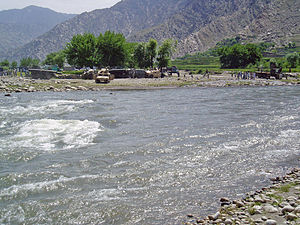| This article needs additional citations for verification. Please help improve this article by adding citations to reliable sources. Unsourced material may be challenged and removed. Find sources: "Pech River" – news · newspapers · books · scholar · JSTOR (November 2024) (Learn how and when to remove this message) |
| Pech River | |
|---|---|
 Members of TF Spartan during an assessment of the river valley in April 2008 Members of TF Spartan during an assessment of the river valley in April 2008 | |
| Location | |
| Country | Afghanistan |
| Physical characteristics | |
| Source | |
| • coordinates | 35°26′8.87″N 70°32′8.65″E / 35.4357972°N 70.5357361°E / 35.4357972; 70.5357361 |
| Mouth | Kunar River |
| • location | Asadabad |
| • coordinates | 34°52′17.15″N 71°9′33.76″E / 34.8714306°N 71.1593778°E / 34.8714306; 71.1593778 |
| • elevation | 812 m (2,664 ft) |
| Basin features | |
| River system | Kunar River → Kabul River → Indus River |
| Tributaries | |
| • left | Waygal River |

The Pech River (Pashto: پېچ سيند) is located in eastern Afghanistan.
Course
The Pech River system is fed from glaciers and snow from the Hindu Kush range to its north. The river rises in central Nuristan Province and flows south and southeasterly through the center of Kunar Province, joining the Kunar River (Asmar River, Loy Seend) at the provincial capital of Asadabad. The Kunar is a tributary of the Kabul River, part of the Indus River basin.
The river has numerous tributaries forming valleys on both sides. These include the Chapa Dara, Waygal, Korangal Valley (site of the film Restrepo), Watapur, and Sharyak valleys.
Culture
In the Pech Valley, Pashto and the Askunu languages are spoken. The Safi tribe of Pashtuns is the majority population in the Pech Valley.
The river's largest settlement is Nangalam, at the confluence of the Waygal River with the Pech River.
Military history
There were a series of U.S. military bases along the Pech River Valley in Kunar Province, including COP Honaker-Miracle, COP Able Main, COP Michigan, and the largest − FOB Blessing. Most were closed after 2011. In 2011 former FOB Blessing was abandoned by the Afghan National Army (ANA), and the 25th Infantry Division returned to reestablish the area of influence. The new name was COP Nangalam, with a majority of control in the hands of the ANA. In late 2012 with the ANA in control of and the establishment of ANA Fire bases in and along the area that COP Michigan was the U.S. Army's 4th Infantry Division's 4th Brigade Combat Team. U.S. President Barack Obama then pulled the American forces from the valley again, ceding it to the Taliban due to the questionable ability and loyalty of the ANA.
The 2012 book Siren's Song: The Allure of War, by Antonio Salinas, depicts the experience of an American platoon operating in the Pech River Valley.
The 2016 book Hammerhead Six: How Green Berets Waged an Unconventional War Against the Taliban to Win in Afghanistan's Deadly Pech Valley, by Ronald Fry with Tad Tuleja, depicts the experience of American Special Forces deployed there.
The 2021 book 'The Hardest Place' by Wesley Morgan details the failed US counterinsurgency campaign in northeastern Afghanistan, including the Pech valley.
See also
References
- Hendricks, Kern (18 Aug 2023). "The former Afghan soldiers turning to gem mining to survive". Al Jazeera. Al Jazeera. Retrieved 22 November 2024.
- Park, David H (May–June 2014). "COINvasion?" (PDF). armyupress.army.mil. Military Review. Retrieved 22 November 2024.
- "'The Hardest Place' details how the US lost the Pech Valley in Afghanistan". Stars and Stripes. Retrieved 2025-01-03.
External links
| Kunar Province | ||
|---|---|---|
| Capital: Asadabad | ||
| Districts |  | |
| Populated places | ||
| Other | ||
| Nuristan Province | ||
|---|---|---|
| Capital: Parun | ||
| Districts |  | |
| Populated places | ||
| Other | ||
This article related to a river in Afghanistan is a stub. You can help Misplaced Pages by expanding it. |